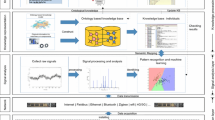Abstract
As the Machinery Condition Monitoring and Fault Diagnosis Systems (MCMFDSs) are more and more complex, the design and development of these systems are becoming a challenge. The best way to manage the complexity and risk is to abstract and model them. This paper presents a new method of modeling Web-based Remote Monitoring and Fault Diagnosis Systems (WRMFDSs) with Unified Modeling Language (UML). A component framework model is put forward. A highly maintainable WRMFDS with three reusable component packages was developed using component-based programming. This paper, which studies a reusable WRMFDS model, aims at making such advanced information technologies be used widely in the condition monitoring and fault diagnosis domain, it can give developers a paradigm to accomplish the similar systems.
Similar content being viewed by others
References
Boggs, W., & Boggs, M. (2000). Mastering UML with Rational Rose. Beijing, China: Electronics Industry.
Booch, G., Rambaugh, J., & Jacobson, I. (2001a). The unified modeling language user guide. Beijing, China: China Machine.
Booch, G., Rambaugh, J., & Jacobson, I. (2001b). The unified modeling language reference manual. Beijing, China: China Machine.
Conallen J. (1999). Modeling web application architectures with UML. Communications of the ACM, 42(10), 63–70.
Eriksson, H. (1996). Expert systems as knowledge servers. IEEE Expert System, 11(3), 14–19.
Gamma, Erich, et al. (2000). Design pattern: Elements of reusable object-oriented software. Beijing, China: China Machine.
Gomaa, H. (2000). Designing concurrent, distributed and real-time applications with UML. Boston, USA: Addison-Wesley.
Grundy, J., & Patel, R. (2001). Developing software components with the UML, Enterprise Java Beans and Aspects. Proceedings of Software Engineering Conference, 127–136.
Itschner, R., Pommerell, C., & Rutishauser, M. (1998). GLASS-remote monitoring of embedded systems in power engineering. IEEE Internet Computing, 2(3), 46–52.
Li, Jingfeng, Jian, Chen, & Ping, Chen (2000). Modeling Web application architecture with UML. Proceedings of the 36th International Technology of Object-Oriented Languages and Systems Conference, 265–274.
Repenning, A., Ioannidou, A., Payton, M., Ye, W., & Roschelle, J. (2001). Using components for rapid distributed software development. IEEE Software, 18(2), 38–45.
Sheldon, F. T., Jerath, K., Young-Jik, Kwon, & Young-Wook, Baik (2002). Case study: Implementing a web based auction system using UML and component-based programming. Proceedings of the 26th Annual International Computer Software and Applications Conference, 211–216.
Weaver, A., Luo, J., & Zhang, X. (1999). Monitoring and control using the Internet and Java. The 25th Annual Conference of the IEEE Industrial Electronics Society, 3, 1152–1158.
Author information
Authors and Affiliations
Corresponding author
Rights and permissions
About this article
Cite this article
Wu, X., Chen, J., Li, R. et al. Modeling a web-based remote monitoring and fault diagnosis system with UML and component technology. J Intell Inf Syst 27, 5–19 (2006). https://doi.org/10.1007/s10844-006-0731-3
Received:
Revised:
Accepted:
Published:
Issue Date:
DOI: https://doi.org/10.1007/s10844-006-0731-3




